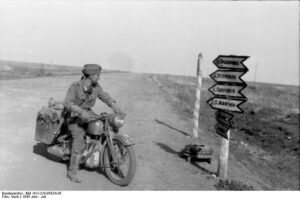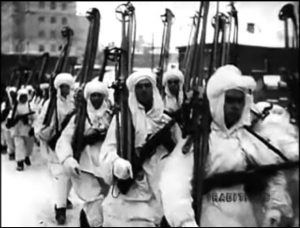russian winter
 The German Kradmelder, motorcycle dispatch rider in English, could be used at any time in history, but in this case, they were used during World War II, specifically on the Eastern Front. The Eastern Front of World War II was a theatre of conflict between the European Axis powers against the Soviet Union (USSR), Poland and other Allies, which encompassed Central Europe, Eastern Europe, Northeast Europe (Baltics), and Southeast Europe (Balkans) from June 22, 1941 to May 9, 1945. The Soviet Union called it the Great Patriotic War, but everyone else called it the Eastern Front.
The German Kradmelder, motorcycle dispatch rider in English, could be used at any time in history, but in this case, they were used during World War II, specifically on the Eastern Front. The Eastern Front of World War II was a theatre of conflict between the European Axis powers against the Soviet Union (USSR), Poland and other Allies, which encompassed Central Europe, Eastern Europe, Northeast Europe (Baltics), and Southeast Europe (Balkans) from June 22, 1941 to May 9, 1945. The Soviet Union called it the Great Patriotic War, but everyone else called it the Eastern Front.
Dispatch riders were used by armed forces to get information from headquarters to the military units. They often didn’t have radios, and depending on the message, they might not have trusted the airwaves with some of the top secret messages. The Nazi Regime never really cared about its soldiers or its people, so the Kradmelder were sent out in the heat of summer or the frigid temperatures of winter. They were expendable, and that was all there was to it. Nevertheless, they played a vital role at a time when telecommunications were limited and insecure. They were also used to deliver carrier pigeons. The pigeons were used to send information back to headquarters, concerning the current situations on the front.
This type of dispatch was essential, but riding on an exposed vehicle in the Russian Winter, was brutal, and even deadly sometimes. During the winter the riders had better have protective clothing, or they could freeze to death.  The Kradfahrer (motorcycle rider) might wear a sentry’s fur-lined overcoat, heavy mittens, the fur-lined cap of the reversible winter suit, which is no doubt being worn beneath the overcoat, and a gas-mask for face protection…with the air filter canister removed from the gas-mask. Special extra eyepiece lens were issued for cold weather to prevent fogging by creating an airspace between the two lens.
The Kradfahrer (motorcycle rider) might wear a sentry’s fur-lined overcoat, heavy mittens, the fur-lined cap of the reversible winter suit, which is no doubt being worn beneath the overcoat, and a gas-mask for face protection…with the air filter canister removed from the gas-mask. Special extra eyepiece lens were issued for cold weather to prevent fogging by creating an airspace between the two lens.
In the summer, the German Kradmelder might wear his rubberized coat (Kradmantel) wrapped and buttoned around his legs to keep dirt and dust off his uniform. Personally, I can’t imagine wearing a rubberized coat in the summer simply to keep the dust off of a uniform. The rider would surly be melting from the heat, but the regime would require that the uniform be neat and clean at all times…even if it was soaked in sweat!! During World War II, the German military was the largest employers of motorcycles. On June 22, 1941 Germany launched its Operation Barbarossa, the 3-million-man invasion of the Soviet Union. The Kradmelder served a variety of functions including chauffeur service for officers, delivering dispatches, hot meals, as scouting patrols, as point vehicles taking the brunt of battle, sometimes as specially equipped tank destroyers. As with all motorcyclists, there was a kinship among these soldiers who called themselves “Kradmelder.” They bravely rode exposed without the armor plating of the Panzers Tanks and without the safety of hundreds of foot soldiers beside them. They were moving targets and sniper magnets. They never knew when they would encounter mine fields, artillery fire, and strafing aircraft, but they bravely went, because Hitler’s orders must be carried out…even if they died trying.
 Besides the known enemy, there was another enemy…the Russian weather. As Autumn approached, the roads had turned into nearly impassable bogs, the fields over which the motorcycles traveled turning in to “seas of jelly three feet more deep.” If that weren’t bad enough, Winter brought falling temperatures, often down to -40° Fahrenheit, causing engine oil and exposed soldiers froze solid. The “lucky” German Kradmelder benefited from special heating systems grafted onto their bikes, including foot and hand warmers. Still there were those who did not have these things, and even these things didn’t totally protect the rider. By the end of World War II, many if not most of the motorcycles, along with their riders, simply never returned home.
Besides the known enemy, there was another enemy…the Russian weather. As Autumn approached, the roads had turned into nearly impassable bogs, the fields over which the motorcycles traveled turning in to “seas of jelly three feet more deep.” If that weren’t bad enough, Winter brought falling temperatures, often down to -40° Fahrenheit, causing engine oil and exposed soldiers froze solid. The “lucky” German Kradmelder benefited from special heating systems grafted onto their bikes, including foot and hand warmers. Still there were those who did not have these things, and even these things didn’t totally protect the rider. By the end of World War II, many if not most of the motorcycles, along with their riders, simply never returned home.
 As a part of his planned world takeover, Hitler had sent his forces to invade the Soviet Union in June 1941. Early on it had become one relentless push inside Russian territory, but the Nazis experienced their first setback in August, when the Soviet Army’s tanks drove the Germans back from the Yelnya salient. A shocked Adolf Hitler told General Bock at the time, “Had I known they had as many tanks as that, I’d have thought twice before invading.” Personally, I doubt that it would have made any difference. Hitler did not particularly care about the lives of his men, just that they perform as they were ordered. For the men, there was no turning back because Hitler would not be moved. Hitler firmly believed that he was destined and well able to succeed in dominating the Soviet Union and capturing Moscow, where others had failed.
As a part of his planned world takeover, Hitler had sent his forces to invade the Soviet Union in June 1941. Early on it had become one relentless push inside Russian territory, but the Nazis experienced their first setback in August, when the Soviet Army’s tanks drove the Germans back from the Yelnya salient. A shocked Adolf Hitler told General Bock at the time, “Had I known they had as many tanks as that, I’d have thought twice before invading.” Personally, I doubt that it would have made any difference. Hitler did not particularly care about the lives of his men, just that they perform as they were ordered. For the men, there was no turning back because Hitler would not be moved. Hitler firmly believed that he was destined and well able to succeed in dominating the Soviet Union and capturing Moscow, where others had failed.
So, on October 2, 1941, the Germans began their surge toward Moscow, led by the 1st Army Group under the General Fedor von Bock. The Germans and Hitler thought they could come in and mow the people down with no resistance. Then they thought they could take their resources from the people to sustain them through the winter months, while they continued to plunder the country. The Russian peasants had different ideas, however.  As the Germans approached, the peasants in their path employed a “scorched earth” policy. I’m not a veteran or anything, so somehow I hadn’t heard of this strategy. The idea is to destroy anything and everything that could be useful to the enemy.
As the Germans approached, the peasants in their path employed a “scorched earth” policy. I’m not a veteran or anything, so somehow I hadn’t heard of this strategy. The idea is to destroy anything and everything that could be useful to the enemy.
This strategy could prove especially useful for the Soviet Union because of the harsh Russian winter. The Russians remembered Napoleon and the fateful winter he and his men spent in the frigid Russian winter. The peasants began destroying everything as they fled their villages, fields, and farms. Harvested crops were burned, livestock were driven away, and buildings were blown up, leaving nothing of value behind to support exhausted troops. Hitler’s army invaded Russia to find nothing but ruins. On top of the lack of shelter and food, winter was upon them, and they were in trouble.
Hitler was a stubborn cuss, and although some German generals had warned him against launching Operation Typhoon as the harsh Russian winter was just beginning, he would not be moved. The generals remembered the fate of Napoleon, who got stuck in horrendous conditions. Over the course of that winter, Napoleon lost  serious numbers of men and horses. Still, some people urged him on. This encouragement, coupled with the fact that the German army had taken the city of Kiev in late September, caused Hitler to declare, “The enemy is broken and will never be in a position to rise again.” So for 10 days, starting October 2, the 1st Army Group drove east, drawing closer to the Soviet capital each day, but by the time the operation was over on January 7, 1942, the German army had not reached Moscow. German casualties amounted to 460,000 men, many of whom were frozen to death due to the lack of proper clothing to handle the harsh Russian winters. It was a catastrophic loss to the the German army.
serious numbers of men and horses. Still, some people urged him on. This encouragement, coupled with the fact that the German army had taken the city of Kiev in late September, caused Hitler to declare, “The enemy is broken and will never be in a position to rise again.” So for 10 days, starting October 2, the 1st Army Group drove east, drawing closer to the Soviet capital each day, but by the time the operation was over on January 7, 1942, the German army had not reached Moscow. German casualties amounted to 460,000 men, many of whom were frozen to death due to the lack of proper clothing to handle the harsh Russian winters. It was a catastrophic loss to the the German army.

